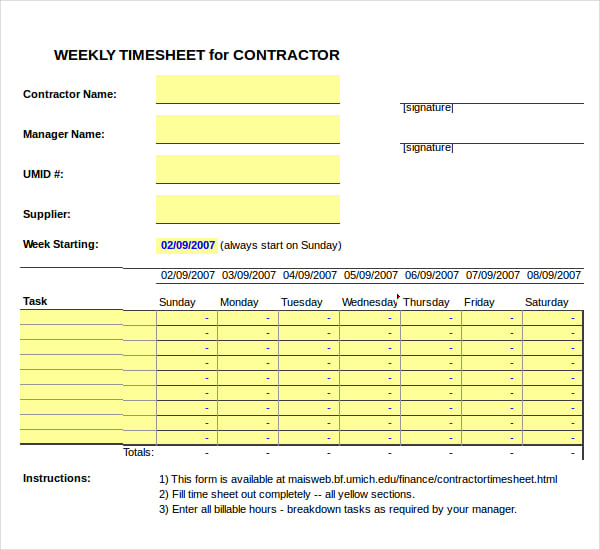Contractor timesheets play a crucial role in accurately tracking the time and effort expended by contractors on various projects. These timesheets serve as a record of hours worked, tasks completed, and expenses incurred. In this comprehensive guide, we will delve into the significance of contractor timesheets, how they are used, and why they are essential for businesses and contractors alike.
What is a Contractor Timesheet?
A contractor timesheet is a document that contractors use to record the number of hours they have worked on a project. It typically includes information such as the date, task performed, time in and time out, breaks taken, and any additional notes or comments. This record allows contractors to accurately bill clients for the work performed and provides a detailed account of their productivity.
Why Do Contractors Need Timesheets?
Contractors need timesheets for several reasons:
- Accurate Billing: Timesheets serve as evidence of the work completed, ensuring accurate billing and preventing disputes over hours worked.
- Project Management: Timesheets provide valuable insights into project progress, allowing contractors to track their productivity and identify areas for improvement.
- Compliance: Timesheets are often required for compliance with labor laws and regulations, ensuring contractors are paid fairly and by legal requirements.
- Cost Analysis: Timesheets enable contractors to analyze their costs and expenses, helping them make informed decisions regarding pricing and budgeting for future projects.
How to Create an Effective Contractor Timesheet
Creating an effective contractor timesheet involves considering the specific needs of the project and the contractor. Here are some key elements to include:
- Contractor Information: Start by including the contractor’s name, contact information, and any relevant identification numbers.
- Project Details: Clearly state the project name, client name, and any other relevant project details to provide context.
- Date and Time: Include a space for the date and time of each entry to accurately record when the work was performed.
- Task Description: Provide a brief description of the task or activity performed during the recorded period.
- Hours Worked: Include fields for the start and end times of each work session, as well as the total hours worked.
- Breaks and Overtime: Allow space for recording breaks taken and any overtime hours worked.
- Expenses: If applicable, include a section for recording any expenses incurred during the project.
- Comments: Provide space for contractors to add any additional comments or notes regarding the work performed.
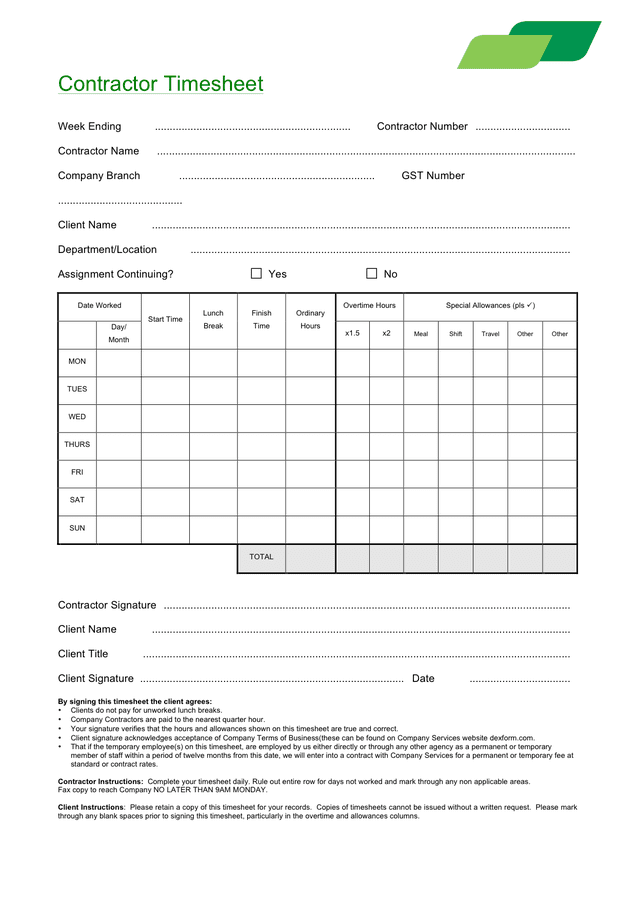
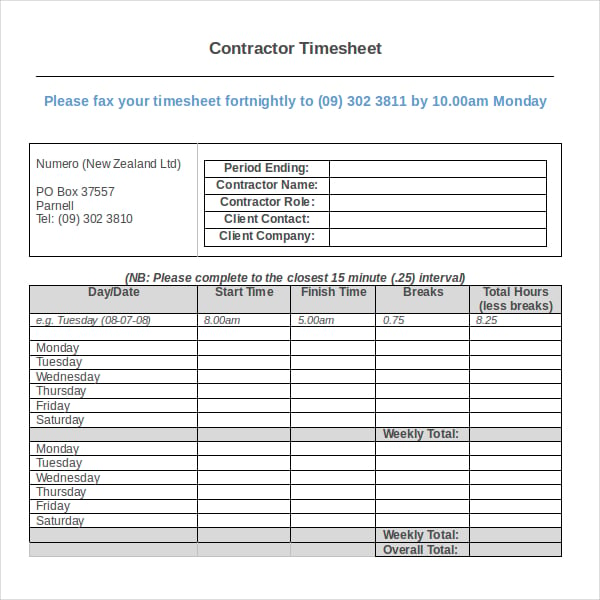
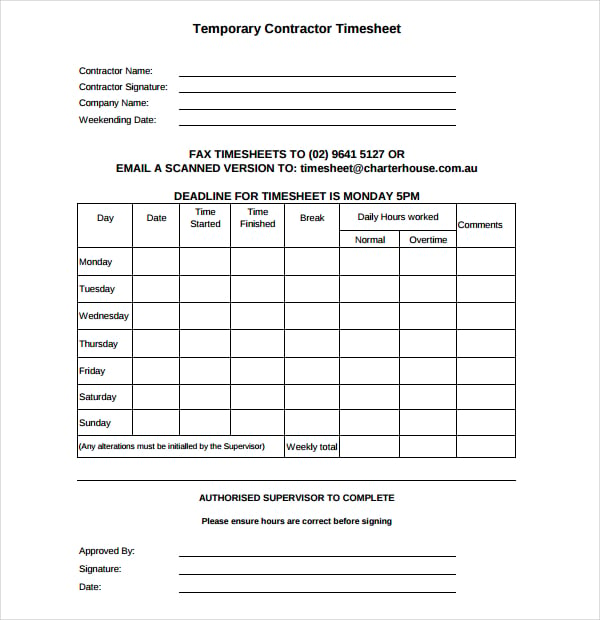
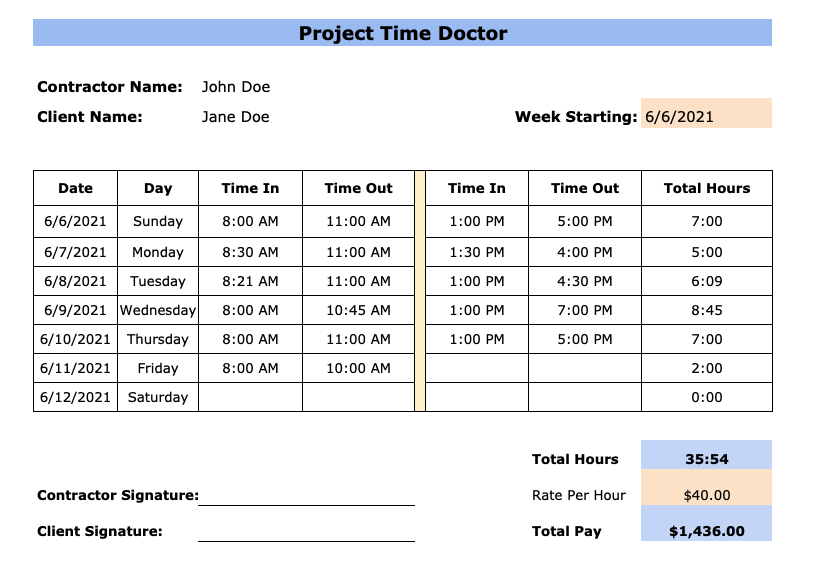
Best Practices for Filling Out a Contractor Timesheet
Here are some best practices to ensure accurate and effective completion of contractor timesheets:
- Record Time Daily: Encourage contractors to record their time daily to ensure accuracy and prevent potential errors or omissions.
- Be Specific: Contractors should provide detailed descriptions of the tasks performed to provide clarity and context.
- Track Time Realistically: Contractors should strive to accurately record the time spent on each task, avoiding overestimation or underestimation.
- Review and Verify: Contractors should review their timesheets before submitting them, ensuring accuracy and completeness.
- Submit on Time: Contractors should submit their timesheets promptly to prevent delays in invoicing and ensure timely payment.
Benefits of Using Contractor Timesheets
Using contractor timesheets offers several benefits for both contractors and businesses:
- Accurate Invoicing: Timesheets provide an accurate record of work performed, ensuring clients are billed correctly.
- Efficient Project Management: Timesheets help contractors track project progress and identify areas for improvement.
- Improved Productivity: Contractors can analyze their timesheets to identify patterns and optimize their workflow for increased productivity.
- Transparent Communication: Timesheets promote transparency and accountability between contractors and clients, fostering trust and collaboration.
- Legal Compliance: Timesheets help ensure compliance with labor laws and regulations, protecting both contractors and businesses.
Conclusion
Contractor timesheets are invaluable tools for accurately tracking and documenting the work performed by contractors. They play a vital role in ensuring accurate billing, project management, compliance, and cost analysis. By using contractor timesheets effectively, contractors and businesses can improve productivity, promote transparency, and enhance collaboration. Choosing the right timesheet software can further streamline the time-tracking process and provide additional benefits for both contractors and businesses.
Contractor Timesheet Template Excel – Download
